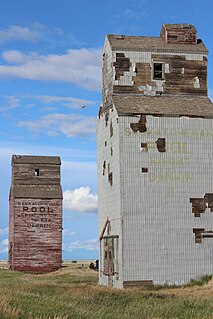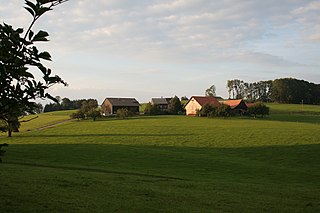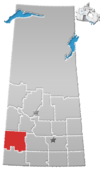
Piapot is a hamlet within the Rural Municipality of Piapot No. 110, Saskatchewan, Canada. Listed as a designated place by Statistics Canada, the hamlet had a population of 50 in the Canada 2016 Census.

Beaver Creek is a hamlet in the Rural Municipality of Dundurn No. 314, Saskatchewan, Canada. Listed as a designated place by Statistics Canada, the hamlet had a population of 107 in the Canada 2016 Census.
Burgis Beach is a hamlet in the Canadian province of Saskatchewan. Listed as a designated place by Statistics Canada, the hamlet had a population of 90 in the Canada 2006 Census.
Gronlid is a hamlet in the Canadian province of Saskatchewan. Listed as a designated place by Statistics Canada, the hamlet had a population of 60 in the Canada 2006 Census.
Hazel Dell is a hamlet in the Canadian province of Saskatchewan. Listed as a designated place by Statistics Canada, the hamlet had a population of 15 in the Canada 2011 Census.
Hitchcock Bay is a hamlet in the Canadian province of Saskatchewan. Listed as a designated place by Statistics Canada, the hamlet had a population of 15 in the Canada 2006 Census.

Jasmin is a hamlet in the Canadian province of Saskatchewan. Listed as a designated place by Statistics Canada, the hamlet had a population of 5 in the Canada 2011 Census.
Ketchen is a hamlet in the Canadian province of Saskatchewan. Listed as a designated place by Statistics Canada, the hamlet had a population of 15 in the Canada 2006 Census.

Kuroki is a hamlet in the Rural Municipality of Sasman No. 336, Saskatchewan, Canada. Listed as a designated place by Statistics Canada, the hamlet had a population of 50 in the Canada 2016 Census. The community is named after the Japanese general Kuroki Tamemoto.
Little Fishing Lake is a hamlet in the Canadian province of Saskatchewan. A popular summer resort for those that are seeking a great beach and swimming area and the possibility of catching a big Northern Pike or a feed of Pickerel fish. Power water sports and wilderness trails add to the allure. This area lies within the Bronson Lake Provincial recreation area. A rustic campground, convenience store, and a subdivision are developed around the lake. As a designated place by Statistics Canada, the hamlet had a year-round population of 25 in the Canada 2006 Census.
Lone Rock is a hamlet in the Canadian province of Saskatchewan. Listed as a designated place by Statistics Canada, the hamlet had a population of 83 in the Canada 2006 Census.
Mikado is a hamlet in the Canadian province of Saskatchewan. Listed as a designated place by Statistics Canada, the hamlet had a population of 56 in the Canada 2006 Census. The hamlet is part of the rural municipality of Sliding Hills No. 273. It has a flag stop for Via Rail's Winnipeg-Churchill train.

North Shore Fishing Lake is a hamlet in the Rural Municipality of Sasman No. 336, Saskatchewan, Canada. Listed as a designated place by Statistics Canada, the hamlet had a population of 50 in the Canada 2016 Census.

Ottman-Murray Beach is a hamlet in the Canadian province of Saskatchewan. Listed as a designated place by Statistics Canada, the hamlet had a population of 15 in the Canada 2016 Census.
Prairie River is a hamlet in the Canadian province of Saskatchewan. Listed as a designated place by Statistics Canada, the hamlet had a population of 35 in the Canada 2006 Census. The hamlet contains the Prairie River railway station now used to house the Prairie River Museum. The Location is 1510 ft above sea level, and is located in the Central Standard time zone, or CST. It does not observe daylight saving time. the telephone area codes for the area are (306) and (639).
Runnymede is a hamlet in the Canadian province of Saskatchewan. Listed as a designated place by Statistics Canada, the hamlet had a population of 15 in the Canada 2006 Census.

Tuffnell is a hamlet in the Canadian province of Saskatchewan. Listed as a designated place by Statistics Canada, the hamlet had a population of 10 in the Canada 2006 Census.
Wishart is a hamlet in Emerald Rural Municipality No. 277 in the Canadian province of Saskatchewan. It is listed as a designated place by Statistics Canada. The hamlet had a population of 95 in the Canada 2006 Census. It previously held the status of village until January 1, 2002. The hamlet is located 32 km south west of the village of Elfros at the intersection of highway 639 and highway 743.
Chesterfield No. 261 is a rural municipality in the Canadian province of Saskatchewan, located in the Census Division 8. The seat of the municipality is located in the Town of Eatonia.

Newcombe No. 260 is a rural municipality in west-central Saskatchewan, Canada encompassing 1,075.60 square kilometers in area. The rural municipality is at the intersection of Highway 21 and Highway 44. The Lemsford Ferry is located within the rural municipality. The rural municipality maintains its office in Glidden, Saskatchewan. The rural municipality in conjunction with the provincial government is in charge of maintenance of highways in its area. The rural municipality was established in 1911 and is named after Allan Simpson Newcombe who played a leadership role in establishing the Boston Colony of immigrants from Massachusetts. Glidden is named after Charles Glidden who sold the town site to the Canadian Pacific Railway.






